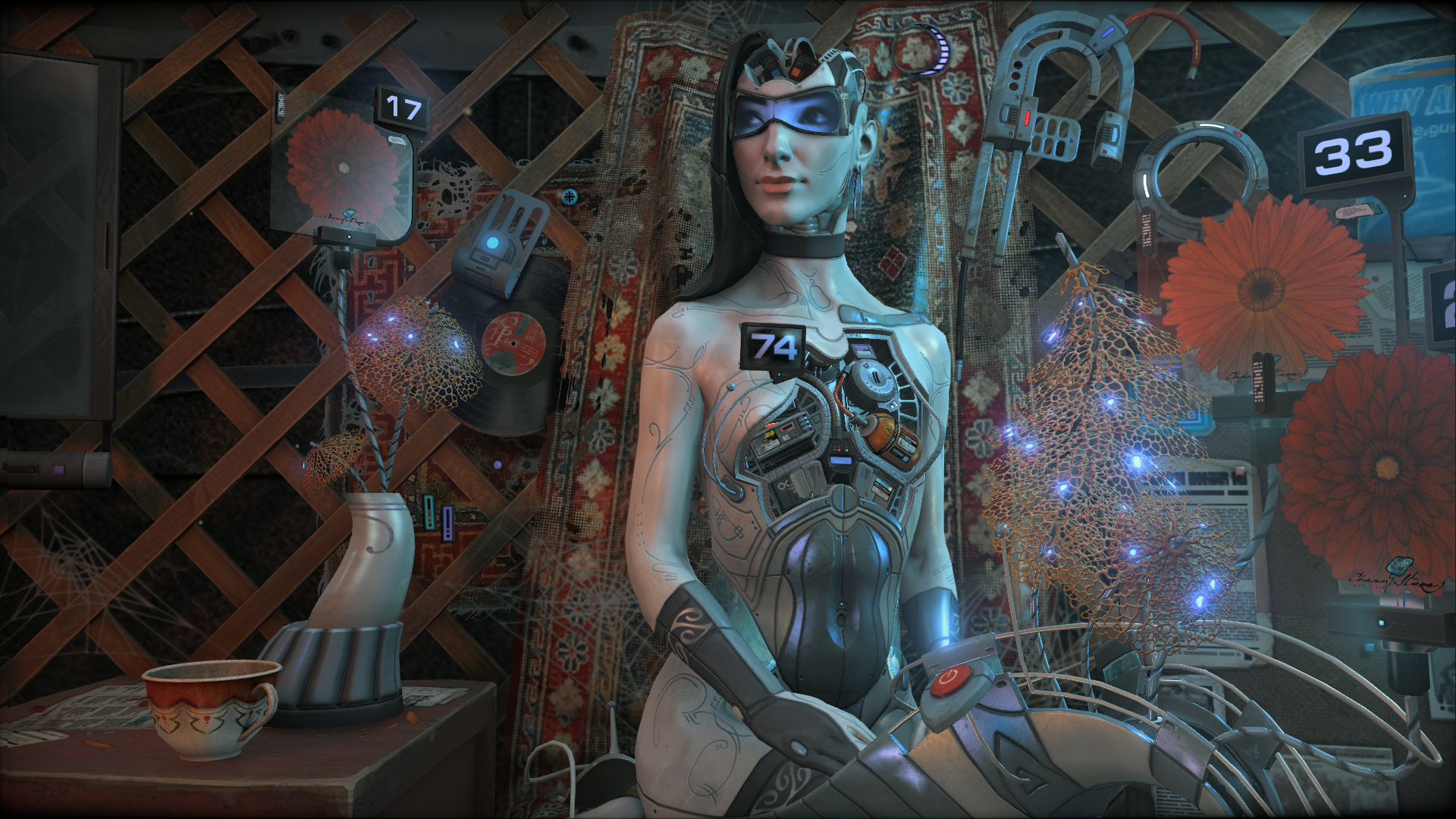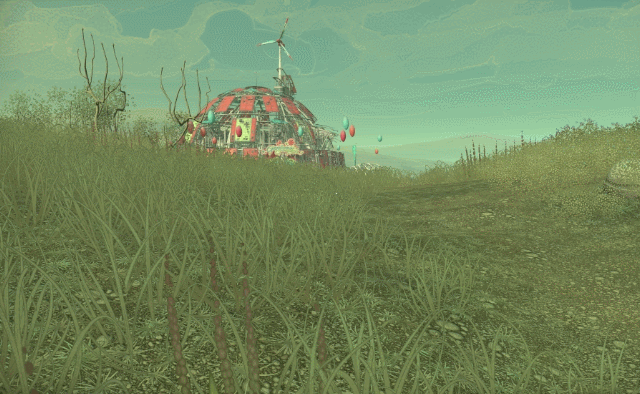Why Cradle and its giant cybernetic eagle could become a cult classic

[Note: This article has some spoilers, so I highly recommend playing Cradle first. It's cheap.]
Cradle is the worst good (or best bad) game I've played in a while. It's a charming, confused piece of work that succeeds despite itself. The puzzles are bad, and the whole thing is strange and discordant—an unevenly translated Ukranian adventure game about transhumanism (the evolution of humankind through technology), nature, identity, and preparing food for a giant cybernetic eagle.
But Kiev-based studio Flying Cafe for Semianimals have ultimately delivered a rare breed of game. It's great because of its flaws, and while I don't know if it'll ever gain popular recognition, Cradle will certainly resonate with a niche audience over time. Like a cult film, it'll be one to share with friends, enjoying its heart and its blunders together.
Yurt telling me!
As Cradle begins, I wake up in a yurt in future rural Mongolia, and am prompted to prepare a brew for an impending airborne guest. Garish on-screen text guides me, overlaying an incredibly dense domestic scene. The yurt is littered with mementos, and there are plenty of drawers to rifle through. There’s lots of visual information I can use to form an unrefined idea of my blank slate character, but looking at this stuff is mostly optional. The majority of my time is spent fumbling with found objects to achieve directed goals, like looking through cabinets to find a bowl, filling it with water, and starting a fire in the stove.
It’s very much traditional adventure game action, in that I have an inventory and I’m using objects on one another to complete tasks (but I would hesitate to say I ever solved any complex puzzles). I figure the entire game will just take place in this small abode, a micro imitation of Gone Home, but then the text prompt tells me to go outside.
The first time I open the door of my yurt, I'm awed. I see a lovely pastoral scene, green hills lolling into an infinite horizon, trees and rocks dotting the landscape, and sunlight glinting off a river in the foothills. It's a relieving departure from typical sci-fi fare, where everything, top to bottom, is metal and beeps. An on-screen prompt tells me to find some fruit for the brew down by the water. So I eagerly venture out. With a bit of trouble and time, I find the tree, but the fruit is too high to reach. Ah, a puzzle. I trust my logic and figure I have to throw something up there to knock the fruit down. After a brief survey of my surroundings, I try to pick up one of the sticks littering the ground. But I can’t.
The sticks are firmly bolted to the artificial gameworld ground. I click like a jackhammer. Come here, stick. At this point, clicking away, I remember my right index finger is attached to my hand, which joins at the wrist to my forearm, and so on, until I’m completely aware of my body. And some of the magic is gone.
Keep up to date with the most important stories and the best deals, as picked by the PC Gamer team.
The inconsistencies in what I can interact with and can’t are jarring, especially when I was encouraged to interact with everything in the yurt. I’m forced to abandon logic because the game won’t support it. I have to truck back to the yurt, pick up a bowl, and throw it into the tree to get at the fruit. If it weren’t for Cradle’s ability to awe and intrigue me with the way it slowly reveals itself, this might have been where I stopped playing normally—but when I finished the brew, my guest arrived. It was a massive cybernetic eagle named Ongot. There was a hole in its chest with a letter inside. That’s one way to set a hook.
Of several minds
One hour in, I throw some flowers into a phtyo-copier that looks straight out of Office Space 2020—yeah, hypothetical future tech that literally clones the genetic code of a flower and captures the sensation of being incredibly tedious to use.
Ida talked me through it. She’s a real human in data form installed on a robot in my yurt. I found clues left to me by a family member and dug her consciousness—or at least the data containing a copy of it—out from beneath a tree. Throughout Cradle, you’ll be replacing Ida’s parts and talking to her. With each new part, you'll have to open her up while she talks you through it. Her scared dialogue ("Here come the shakes again...") does well to humanize her and give weight to otherwise routine actions. Both of you are attempting to reconcile your past. Why did your family hide her and leave clues to her data disk’s whereabouts? What does she know about you? About herself? The mysterious, rundown amusement park in the distance? There’s plenty to unearth here.
The setting feeds into an overarching sense of decay and a fight for renewal. Everything is in a state of disrepair: Ida is assembling (literally and figuratively) her identity and in turn, filling in the blanks of the player’s history.
Through interacting with Ida, Cradle blooms. It becomes a rare game that embraces subtly at the risk of alienating the easily bored. She’s able to explore more of her memory banks as the story progresses, which leads to large bouts of exposition, but in a game that implies an unknown history and world state, the spoon fed information is welcome. That said, over the four or five hours I spent with Cradle, I never felt like I completely grasped what had happened to set up its rusty, transhumanist circumstance, but I also didn’t feel like knowing was necessary.
There was no ‘aha’ moment where the science-fiction coalesced into a cerebral bullet and blew out the back of my cyborg skull. Instead, Cradle banks on quiet clues scattered throughout the environments and conversations with the few supporting characters to evoke a sense of depth. These characters and conversations are only the tip of a very large iceberg chilling beneath the surface. A shame the block puzzles didn’t take a dive too.
Blocked off
Shortly after meeting Ida, I explore the top tier of an abandoned amusement park—I’m looking for a new lens so she can ‘see’ again. I enter a padded, windowless room. The lights dim, my vision fades, and the instructions for a virtual block-based puzzle game appear on screen. It’s here where the tone of Cradle changes significantly, from Gone Home to ‘Go home, block minigames, you’re drunk.’
The music goes funky, textures soften up and glow, and you’re asked to dash around an environment composed of brightly colored cubes to collect, well, a certain amount of certain brightly colored cubes. For a game so grounded in its own reality, playing mundane arcade block-collecting games, metaphor or not, felt beside the point.
And they’re bad. Really bad. Platforming is loose and floaty, picking up and throwing objects is more cumbersome than it should be, and even though the lucid stages function as metaphor in the narrative, I still can’t understand how they couldn’t have been something much simpler. As it stands, they muddy Cradle’s pace, but skirt by on their baffling novelty, charming in the same vein as popcorn sex. At their worst, they’re inoffensive and never too difficult. I just—why?
The good news: There aren’t many, and after each, I took a massive slide back to the ground floor of the amusement park to pass on my prizes to Ida.
Volatile memory
Cradle’s wild turns in narrative and design make it feel out of place in the modern gaming sphere, like it came out in the early nineties with modern technology—more than once I wondered if it had translation issues, but I resisted the urge to do any research until I’d finished. And strangely, though it did have translation problems, they were to Cradle’s benefit. The strange errors in dialogue and writing didn't prevent me from understanding what I heard or read, but colored it with the impression that I was somewhere familiar, only obscured by time and place. That is, except for the time I was told to search for an object near a “lake” only to find out it was referring to a small pond. That was a lot of wasted walking.
The ideas in Cradle are so wildly incongruent that they evoke a discordant charm.
The density of blunders gave me the eerie sense that Cradle is some future, more evolved human’s approximation of what an adventure game might have been to former humans, cobbled together from weather worn bits and pieces, loose assemblages of history and stories—exploration and bad minigames.
But all the ideas in Cradle are so wildly incongruent that they evoke a discordant charm. The shifts in tone and action forced me to reorient myself every time, which was its own ‘game’ of sorts. Everything wrong with Cradle is somehow right in its greater context, and it’s because of this weirdly paradoxical state that it feels like a secret. Like a cult film, it's a secret I want to share with the people I know best, giving the narrative its deserved attention and care and inquisition while laughing together at the charming missteps.
James is stuck in an endless loop, playing the Dark Souls games on repeat until Elden Ring and Silksong set him free. He's a truffle pig for indie horror and weird FPS games too, seeking out games that actively hurt to play. Otherwise he's wandering Austin, identifying mushrooms and doodling grackles.





